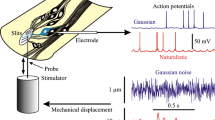Abstract
A square pulse of increased temperature often produces in nerve systems two response transients of opposite sign at the start and end of the temperature pulse. This is characteristic of a pyroelectric process. It is seen in the fish thermoreceptor, which also shows proportionality between the time derivatives of response and temperature which is predicted from pyroelectric theory. The muscle stretch receptor shows linearity of neural response with the logarithm of applied mechanical force. This is predicted from the concept that the neural response is governed by a piezoelectric effect in an elastic polymer macromolecule.
Similar content being viewed by others
Literature
Bassett, C. A. L. and R. O. Becker. 1962. “Generation of Electric Potentials by Bone in Response to Mechanical Stress.”Science 137, 1063–1064.
Bazhenov, V. A. 1961.Piezoelectric Properties of Wood. New York: Plenum Press.
Becker, R. O., C. A. Bassett and C. H. Bachman. 1964. “Bioelectric Factors Controlling Bone Structure.” InBone Biodynamics, H. Frost ed. New York: Little, Brown and Co.
Bernhard, C. G. and R. Granit. 1946. “Nerve as a Model Temperature End Organ.”J. Gen. Physiol.,29, 257–265.
Boring, E. G. 1950.A History of Experimental Psychology. Second edition. New York: Appleton-Century-Crofts. Pages 284–295.
Brailsford, F. 1966.Physical Principles of Magnetism. London: Van Nostrand.
Burkhardt, D. 1959. “Die Erregungsvorgänge sensible Ganglienzelle in Abhängigkeit von der Temperatur.”Biol. Zentralblatt,78, 22–62.
Cady, W. G. 1964.Piezoelectricity. Revised edition. New York: Dover Publications.
Chynoweth, A. G. 1956a. “Dynamic Method for Measuring the Pyroelectric Effect with Special Reference to Barium Titanate.”J. Appl. Physics,27, 78–84.
—, 1956b. “Surface Space-Charge Layers in Barium Titanate.”Phys. Rev.,102, 705–714.
Cope, F. W. 1969. “Theory of the Effect of Externally Applied Voltage on Membrane Oxidation Kinetics.”Bull. Math. Biophysics,31, 519–527.
Cope, F. W. 1970. “The Solid State Physics of Electron and Ion Transport in Biology.”Adv. Biol. Med. Physics,13, 1–42.
—, 1971a. “Temperature Dependence of the Elovich Equation Derived from Activated Electron or Ion Transport across a Biological Interface, with an Application to Muscle Spindle Adaptation.”Bull. Math. Biophysics,33, 39–47.
— 1971b. “The Solid State Physical Theory of Cytochrome Oxidase Kinetics. Inhibition of Second Order Rate Constant, and Second to First Order Kinetic Shift with Increasing Oxygen, Predicted from Electron Injection and Trapping” ——Ibid.,33, 579–588.
— 1971c. “Evidence from Activation Energies for Superconductive Tunneling in Biological Systems at Physiological Temperatures.”Physiol. and Chem. Physics,3, 403–410.
— 1972. “Generalizations of the Roginsky-Zeldovich (or Elovich) Equation for Charge Transport across Biological Surfaces.”Bull. Math. Biophysics,34, 419–427.
— 1973. “Supramolecular Biology—Toward a Solid State Physical Theory.”Ann. N.Y. Acad. Sci.,204, 416–433.
— and K. D. Straub. 1969. “Calculation and Measurement of Semiconduction Activation Energy and Electron Mobility in Cytochrome Oxidase, with Evidence that Charge Carriers are Polarons, which may Couple Oxidation to Phosphorylation.”Bull. Math. Biophysics,31, 761–774.
Duchesne, J., J. Depireux, A. Bertinchamps, N. Cornet and J. M. van der Kaa. 1960. “Thermal and Electrical Properties of Nucleic Acids and Proteins.”Nature,188, 405–406.
Evans, S. M. 1948. “Tissue Responses to Physical Forces. I. The Pathogenesis of Silicosis. A Preliminary Report.”J. Indust. Hygiene and Tox.,30, 353–356.
— and W. Zeit. 1949a. “Tissue Responses to Physical Forces. II. The Response of Connective Tissue to Piezoelectrically Active Crystals.”J. Lab. Clin. Med.,34, 592–609.
— and —. 1949b. “Tissue Responses to Physical Forces. III. The Ability of Galvanic Current Flow to Stimulate Fibrogenesis.” ——Ibid.,34, 610–615.
Frank, N. H. 1940.Introduction to Electricity and Optics. New York: McGraw-Hill Book Co.
Fukada, E. 1955. “Piezoelectricity of Wood.”J. Phys. Soc. Japan,10, 149–154.
— 1968a. “Piezoelectricity in Polymers and Biological Materials.”Ultrasonics,6, 229–234.
— 1968b. “Mechanical Deformation and Electrical Polarization in Biological Substances.”Biorheology,5, 199–208.
Hensel, H. 1955. “Quantitative Beziehungen zwischen Temperaturreiz und Actionpotentialen der Lorenzinischen Ampullen.”Zeitscher. vergl. Physiol.,37, 509–529.
— and Y. Zotterman. 1951. “Quantitative Beziehungen zwischen der Entladung einzelner Kältefasern und der Temperature.”Acta Physiol. Scand.,23, 291–319.
James, H. M. and E. Guth. 1943. “Theory of the Elastic Properties of Rubber.”J. Chem. Physics,11, 455–481.
Johnson, F. H., Eyring, H. and M. J. Polissar. 1954.The Kinetic Basis of Molecular Biology. New York: John Wiley & Sons.
Kerkut, G. A. and B. J. R. Taylor. “Effect of Temperature on the Spontaneous Activity from the Isolated Ganglia of the Slug, Cockroach and Crayfish.”Nature,178, 426.
— and —. 1958. “The Effect of Temperature Changes on the Activity of Poikilotherms.”Behavior,13, 259–279.
— and R. M. A. P. Ridge. 1962. “The Effect of Temperature Changes on the Activity of the Neurones of the Snail Helix Aspersa.”Comp. Biochem. Physiol.,5, 283–295.
King, A. 1946. “Law of Elasticity for an Ideal Elastomer.”Amer. J. Physics,14, 28–30.
— and R. W. Lawton. 1950. “Elasticity of Body Tissues.” inMedical Physics, Volume 2, O. Glasser ed. Chicago: Year Book Publishers. Pages 303–316.
Mathews, B. H. C. 1931. “The Response of a Single End Organ.”J. Physiol.,71, 64–110.
Sand, A. 1938. “The Function of the Ampullae of Lorenzini, with Some Observations on the Effect of Temperature on Sensory Rhythms.”Proc. Roy. Soc. (London),B125, 524–553.
Shamos, M. H., L. S. Lavine and M. I. Shamos. 1963. “Piezoelectric Effect in Bone.”Nature,197, 81.
Stevens, S. S. and H. Davis. 1938.Hearing, Its Psychology and Physiology. New York: John Wiley & Sons.
von Hippel, A. 1959.Molecular Science and Molecular Engineering. New York: John Wiley & Sons.
Author information
Authors and Affiliations
Rights and permissions
About this article
Cite this article
Cope, F.W. Piezoelectricity and pyroelectricity as a basis for force and temeprature detection by nerve receptors. Bltn Mathcal Biology 35, 31–41 (1973). https://doi.org/10.1007/BF02558791
Issue Date:
DOI: https://doi.org/10.1007/BF02558791




